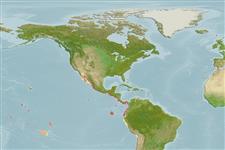>
Carangiformes (Jacks) >
Carangidae (Jacks and pompanos) > Trachinotinae
Etymology: Trachinotus: Greek, trachys, -eia, -ys = rough + Greek,noton = back (Ref. 45335).
Eponymy: C W Kennedy was Lieutenant Commander on the Hassler Expedition (1871–1872) from Boston to San Francisco via the Straits of Magellan. [...] (Ref. 128868), visit book page.
More on author: Steindachner.
Environment: milieu / climate zone / depth range / distribution range
Écologie
marin; saum�tre d�mersal. Tropical; 33°N - 20°S
Eastern Pacific: Bahía Magdalena, Baja California Sur, Mexico and southern Gulf of California to Ecuador.
Taille / Poids / Âge
Maturity: Lm ? range ? - ? cm
Max length : 90.0 cm TL mâle / non sexé; (Ref. 55763); common length : 40.0 cm TL mâle / non sexé; (Ref. 55763)
Description synthétique
Clés d'identification | Morphologie | Morphométrie
Body short, deep, and compressed; mouth small; teeth small, villiform, and only slightly hooked, didsappearing with age; lower branch of first gill arch with 9 to 12 gill rakers; dorsal fin with 6 spines followed by another spine and 17 to 19 soft rays (VII+I,17-19); nape prominent in adults; upper third of head and body dark; belly silvery; a dark axillary stain I covered by the pectoral fin (Ref. 55763).
Adults occur in coastal waters (Ref. 9283). They are common in shallow water and feed mainly on mollusks, but also take crustaceans and small fishes (Ref. 9283). Juveniles are frequently encountered in estuaries and feed on a variety of benthic invertebrates (Ref. 9283). Marketed fresh and salted or dried (Ref. 9283).
Life cycle and mating behavior
Maturité | Reproduction | Frai | Œufs | Fécondité | Larves
Smith-Vaniz, W.F., 1995. Carangidae. Jureles, pámpanos, cojinúas, zapateros, cocineros, casabes, macarelas, chicharros, jorobados, medregales, pez pilota. p. 940-986. In W. Fischer, F. Krupp, W. Schneider, C. Sommer, K.E. Carpenter and V. Niem (eds.) Guia FAO para Identification de Especies para lo Fines de la Pesca. Pacifico Centro-Oriental. 3 Vols. FAO, Rome. (Ref. 9283)
Statut dans la liste rouge de l'IUCN (Ref. 130435: Version 2024-1)
Menace pour l'homme
Harmless
Utilisations par l'homme
Pêcheries: int�r�t commercial mineur; pêche sportive: oui
Outils
Articles particuliers
Télécharger en XML
Sources Internet
Estimates based on models
Preferred temperature (Ref.
123201): 20.8 - 28.5, mean 25.9 °C (based on 60 cells).
Phylogenetic diversity index (Ref.
82804): PD
50 = 0.5000 [Uniqueness, from 0.5 = low to 2.0 = high].
Bayesian length-weight: a=0.01445 (0.00779 - 0.02682), b=2.93 (2.76 - 3.10), in cm total length, based on LWR estimates for this species & (Sub)family-body (Ref.
93245).
Niveau trophique (Ref.
69278): 3.8 ±0.55 se; based on food items.
Résilience (Ref.
120179): Milieu, temps minimum de doublement de population : 1,4 à 4,4 années (Preliminary K or Fecundity.).
Fishing Vulnerability (Ref.
59153): High vulnerability (56 of 100).
